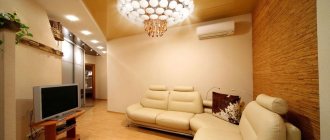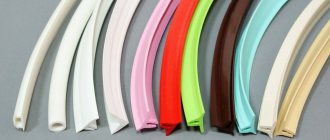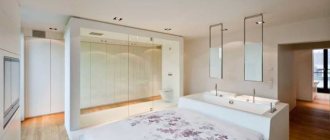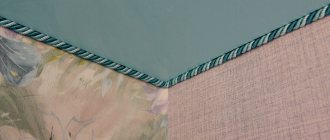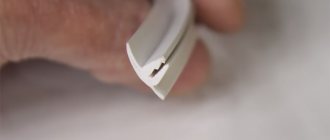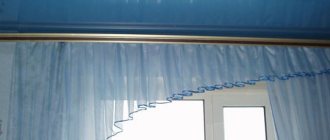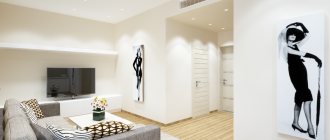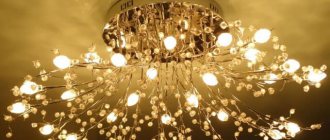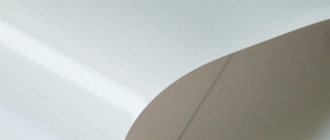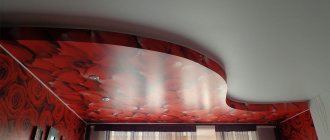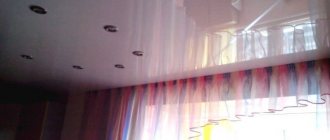Previously, suspended ceilings in the living room were made of stretched fabric, which wore out over time and had to be replaced with a new fabric. Subsequently, the fabric was impregnated with chalk or paint; this method gave density to the material, but it remained just as short-lived. Over time, they began to use other raw materials for finishing, and then stretch ceilings lost their former demand.
In the 20th century, they returned to creating suspended ceilings, only from durable plastic film. Modern technologies have made great strides forward; today you can create a ceiling of any shade or combination of colors. It is possible to combine PVC film with plasterboard structures.
Unusual ceiling in the living room Source satiko.by
Perception of the interior depending on the texture of the ceiling
The surface of a stretch ceiling can be:
- glossy;
- matte;
- satin;
- imitating various materials;
- translucent.
The gloss is smooth and reflects light well, due to which the boundaries of the room are blurred and the ceiling visually becomes higher. This texture has the most color variations. But you should be careful with the lighting, as the light reflects off the film.
The matte finish resembles a painted surface. This is a great way to create a level surface. Bright colors become more saturated. But the ceiling looks lower. This option is best chosen for high rooms. The matte surface is available not only in film, but also in fabric, which allows you to create seamless ceilings. And in PVC fabric this texture is cheaper than others.
The satin surface resembles fabric in appearance, but belongs to PVC fabrics. It has a soft shine that adds air and space to the room. But there will be no reflection of the surrounding environment in the ceilings. The cost is more expensive than matte and gloss.
Textured canvases resemble expensive finishes - suede, leather, various types of stone, metal. The effect is obtained through a combination of microrelief and pattern. It’s not cheap, but it allows you to create a luxurious interior.
Translucent film is used to implement unusual types of lighting. Diodes are placed above the film. Depending on the location of the tape, the entire ceiling, an insert on it, or individual lines glow.
Canvas material
Several types of materials that are used to make matte stretch ceilings.
PVC film
This is the most inexpensive option, which is no different in appearance from a high-quality plastered and whitewashed ceiling.
Fabric
For their manufacture, textile fabrics impregnated with polyurethane are used. They are characterized by good resistance to external influences and tolerate temperature changes well. However, they have a rather high price.
Classic colors for the hall and their combinations
One of the most common is white, which suits almost all styles. For example, the classic one uses a matte texture, often with a figured baseboard. For minimalism, it is better to choose a glossy surface, and for the Scandinavian style, complex configurations are possible. Lacquer texture is used in modern directions. White goes with any color combination, both light and dark.
A radical solution is black ceilings. It is better to make them glossy so that the surface does not hang over your head. In this color the reflective effect will be most pronounced. The rest of the furnishings are kept light so that the living room does not become too gloomy.
Brown shades have a similar effect. But the room turns out to be more comfortable and warm. Blue and purple look elegant and noble, however, sometimes they create a too cold environment.
If you want to install a colored ceiling, but are not ready to experiment, it is better to stick to light colors. Beige is often chosen - warm and delicate. It has several shades to suit different environments. Another common neutral color is gray. May be pale, close to white, or dark. The hall will become strict and solemn.
Pastel colors look gentle and elegant - pink, cream, light green. Blue is reminiscent of the sky and sea.
For suspended ceilings, bright colors are also chosen, for example, red, orange, yellow, green. But it is better to use them fragmentarily, in a small area or in a drawing. Otherwise, the surface will become too flashy, and it will be uncomfortable to be in the living room.
The combinations of shades with each other look interesting. There are several successful options for two-color combinations:
- White matches any others (for example, black and white).
- A dark or bright color with a similar, but very diluted shade (for example, brown and beige) looks good.
- Pastel colors are combined with each other.
For the ceiling you should not choose more than two or three colors. Then it will be harmonious and not colorful.
Forms of two-level ceilings in the living room
Multi-tiered structures are created in two ways. The first option: first install plasterboard boxes, and then stretch the canvas from them. In the second case, the ceilings are made entirely of film stretched over a multi-stage frame. Often different textures and colors are combined.
Each new level takes away height. Therefore, in most cases they are limited to two. They require ceilings with a height of 2.8 meters.
There are a wide variety of forms. The simplest option is a rectangular “frame” around the perimeter. There is a bright insert in the center.
There can be a niche around the chandelier in the form of an oval, circle or square. Sometimes they make a more complex shape - for example, a flower or a star.
Another option is a strip running through the ceiling. The edges can be smooth, wavy or zigzag. This is how studios are often decorated.
With the help of a flexible frame, many unusual shapes are created. One of them is waves over the entire surface or near the wall. In the blue version they resemble the sea, and in the yellow version they resemble sand dunes.
The center can be highlighted with a drop or a bell. This is a good place to place a chandelier. Very complex and not acceptable everywhere - the ceiling is in the shape of an arch with a curve towards the walls. If height allows, you can create a domed vault. And cones are placed in corners or near columns.
These options can be combined with each other. But an abundance of complex shapes is not always suitable for a family living room; it is better to choose a more restrained look.
Hall lighting ideas
There are three main types of lighting - a central chandelier, built-in spots and LED strip. They are used both separately and together. In the latter case, you can vary the lighting, increasing or decreasing the brightness, and highlighting areas for work and relaxation.
Chandelier
It is important to choose the right central device so as not to damage the canvas. Incandescent light bulbs and metal bases are not suitable. This causes the ceiling to melt.
Fortunately, there is a wide selection of chandeliers for LED and energy-saving lamps. When purchasing, take into account the texture of the canvas: the varnish surface will need less light.
Spots
These devices are available built-in and surface-mounted, in different colors, shapes and materials. In most cases, they choose a shade that matches the ceiling or a design reminiscent of a chandelier (if the spotlights are used together with it).
Spot lighting is located:
- evenly across the entire ceiling (then you can do without a chandelier);
- clusters in a certain area (above the sofa or table);
- in two-level structures - along the boundaries between levels;
- The spots are made up of straight and curved lines or various patterns.
LED Strip Light
She has several accommodation options. For example, a floating ceiling. Using special baguettes, a small gap is created between the canvas and the walls. The tape is placed in it. As a result, it seems that the canvas is not adjacent to the walls, that is, the ceiling seems to be hanging in the air.
Sometimes LEDs are placed between the levels of a two-tier structure. Here it seems that one of them is floating, and the difference in height seems greater.
The entire ceiling can glow if you choose a translucent film for it. But more often the insert is designed this way. It looks like a window in the ceiling.
Another interesting design technique is luminous lines. They can be smooth, fold into a pattern, drawing or even a word. Such finishing usually has only a decorative effect.
How to calculate the required number of spotlights
When developing a scheme, the question always arises: how many lamps are needed. In general, it is believed that 20 W are needed to illuminate one square meter of floor area. When calculating, you need to take into account how much lamp power you plan to use. If it is 30-35 W, then it turns out that one lamp can illuminate 1.5 squares (30 W / 20 W/m² = 1.5 m²). Next, divide the area of the room by 1.5, you get the number of lamps that will need to be installed for normal illumination. In this case, there will be enough light for full illumination.
The location of spotlights on the ceiling is not easy to choose
When drawing up a diagram for placing lamps on the ceiling, this number can be slightly adjusted in both directions, adjusting to the type of room. For example, for a bedroom the number can be reduced - it doesn’t require too much light, but for the living room or corridor you can increase it - here it’s better to have some excess. True, in this case it is advisable for the lamps to be turned on in parts - it is advisable to vary the degree of illumination. There should be at least two options: full and partial coverage. To do this, the lamps - through one or some other circuit - are connected to two switch keys.
When using incandescent lamps in spotlights, you can install a dimmer, which will allow you to smoothly change the brightness of the lighting by turning the knob. In general, there are many options. And we haven’t yet gotten to the layout of the spots on the ceiling.
Examples of ceilings with patterns
Modern technologies make it possible to diversify and decorate the ceiling surface. Using photo printing, you can apply any design to the canvas, and the artistic perforation method creates a pattern of cutouts of various shapes. Let's take a closer look at them.
Photo printing
Images occupy the entire canvas or a small part. The themes of the drawings are very different: landscapes, animals, architecture, abstract patterns, ornaments, etc. Numerous samples are available in the photo galleries of companies providing similar services. Eco-solvent, ultraviolet or latex inks are used for printing. The first ones are suitable only for light tones, while the others are clearly visible on dark ones.
Three-dimensional images look interesting, adding space to the living room. You can also combine patterns with backlighting (trees against the sky, stars against a dark sky).
See also: Samples of photo printing on stretch ceilings
Artistic perforation
This is another way to diversify the surface. Two fabrics are stretched at a short distance from each other. Holes are made at the bottom at the factory. They are placed randomly or formed into a recognizable image. The size of the holes can vary from small to large. Perforation can be supplemented with internal lighting between levels.
Stretch ceilings in living rooms with stairs to the second floor
It is not easy to arrange such rooms beautifully and comfortably. Designs with level transitions will help, as well as complex shapes: cones, arches, waves.
You can create the illusion of a window in the ceiling. To do this, install a translucent film and frame it. Often the sky is printed on canvas, sometimes with tree branches, flying birds, etc.
If a fireplace is installed in the hall, you should take care of the safety of the film. A fire-resistant frame is installed between the canvas and the chimney.
Hallway
In the hallway it is better to use a single-level design with spot lighting. For narrow corridors, white color combined with beige walls is suitable. If the hallway is medium in size, then you can make a two-level concave stretch ceiling with a contrasting glossy insert.
Stretch ceilings for a small room
The main recommendations for such rooms are related to the visual increase in the size of the room. To do this, choose a glossy texture and light colors, preferably white or a color from the cold spectrum (blue, pale gray).
In a small room (for example, in a Khrushchev building), the ceiling must be one-level, so as not to take away the height. Often they abandon a bulky chandelier in favor of spotlights or diode strip.
Photos of beautiful ceilings in large living rooms
It is more convenient to divide spacious rooms into zones - for relaxing and watching TV, reading, working, etc. Sometimes the rooms are combined with dining rooms and kitchens.
The design of suspended ceilings in a large hall can be more daring and original. If there are bay windows or niches in the living room, they are emphasized and highlighted with complex ceiling shapes.
For demarcation, combined multi-level structures are installed. For the top tier it is better to choose a glossy or textured film, and for the bottom - matte. A printed picture on the ceiling or perforation will look interesting.
Don't forget about the lighting. It is better to select devices so that they match each other in style. The central chandelier unifies the space, the LED strip emphasizes the boundaries of the levels, and spots add light where it is lacking.
Stretch ceilings in the living room can be either a neutral background or the main accent in the interior. But you need to select them taking into account the entire decor and style of the room.
Manufacturers
Matte canvases are produced by almost all manufacturers of tensile structures, the most important thing is to choose companies whose products are of excellent quality
- Pongs (Germany) is several brands. The brand successfully produces vinyl and fabric ceilings. Fabric products are known as Deckor.
- Clipso (France) is a company that was one of the first to offer customers seamless fabric tension structures. In order to implement this technology, canvases with a width of 5 meters are specially produced. The company's products can be classified as luxury products.
- Polyplast (Belgium and China) - 3 factories operate under this brand. The production facilities specialize in the production of canvases with photo printing using leading digital technologies. The company produces matte, satin and varnish films with a width of 3.2-4-5 meters.
Consumer reviews about these types of canvases are only the most enthusiastic, however, do not forget that Russia also has its own production of matte stretch products.
- Saros design company has been known since 2000. Buyers are offered a choice of several interesting textures: glossy, matte, and satin effect. The company produces canvases with the effect of a starry sky, as well as acoustic products.
- launched the production of stretch fabrics at quite affordable prices. Not long ago, the plant introduced the latest technology that allows combining the advantages of various materials.
